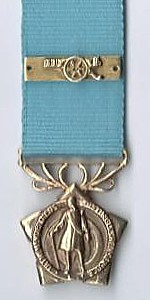|
Van Riebeeck Decoration
The Van Riebeeck Decoration, post-nominal letters DVR, is a South African military decoration for bravery which was instituted by the Union of South Africa in 1952. It was awarded to officers for distinguished service in the field.[1][2] The South African militaryThe Union Defence Forces (UDF) were established in 1912 and renamed the South African Defence Force (SADF) in 1958. On 27 April 1994, it was integrated with six other independent forces into the South African National Defence Force (SANDF).[1][3][4][5][6] InstitutionThe Van Riebeeck Decoration, post-nominal letters DVR, was instituted by Queen Elizabeth II on 6 April 1952, during the Tercentenary Van Riebeeck Festival. The logical post-nominal letters would have been VRD, but since those were already being used for the Decoration for Officers of the Royal Naval Volunteer Reserve, which had also been awarded to South Africans, the letters DVR were chosen instead.[2][7][8] Award criteriaThe Van Riebeeck Decoration was awarded to officers for distinguished service against an enemy in the field. Only two decorations were ever awarded, both in 1972. A silver-gilt bar was authorised to denote a second award, but was never awarded.[1] Order of wearWith effect from 6 April 1952, when the Van Riebeeck Decoration and several other new decorations and medals were instituted, these new awards took precedence before all earlier British orders, decorations and medals awarded to South Africans, with the exception of the Victoria Cross, which still took precedence before all other awards. The other older British awards continued to be worn in the order prescribed by the British Central Chancery of the Orders of Knighthood.[8][9][10] The position of the Van Riebeeck Decoration in the official order of precedence was revised twice after 1975, to accommodate the inclusion or institution of new decorations and medals, first with the integration into the South African National Defence Force on 27 April 1994, and again with the institution of a new set of awards on 27 April 2003.[8]
The position of the Van Riebeeck Decoration in the order of precedence remained unchanged, as it was on 27 April 1994, when decorations and medals were belatedly instituted in April 1996 for the two former non-statutory forces, the Azanian People's Liberation Army and Umkhonto we Sizwe, and again when a new series of military orders, decorations and medals was instituted in South Africa on 27 April 2003. However, the two Police decorations which succeed the Van Riebeeck Decoration, the South African Police Silver Cross for Gallantry (SCG) and the South African Police Cross for Bravery, Silver (PCFS), exchanged seniority in the official order of precedence, as published in 1994 and 2003 respectively.[8][11] Description
The Van Riebeeck Decoration was struck in silver-gilt and is in the shape of the five-pointed outline of the Castle of Good Hope, to fit in a 38 millimetres diameter circle. The suspension consists of a cluster of eight protea leaves. The statue of Jan van Riebeeck, which stands in the Heerengracht in Cape Town, is depicted in relief against a background of three rings, representing Van Riebeeck's three ships, with the outer ring inscribed "UITNEMENDE DIENS" at left and "DISTINGUISHED SERVICE" at right.[1][12]
The reverse has the pre-1994 South African Coat of Arms. Specimens struck before 31 May 1961 had Queen Elizabeth II's royal cipher (E II R) above the coat of arms, but this was removed by the time the decoration was first awarded.
The ribbon is 32 millimetres wide and sky blue.[1]
The Bar displays a field cannon in its centre. When ribbons alone are worn, a separate button displaying a field cannon would have been worn on the ribbon bar. The Bar was never awarded. DiscontinuationThe Van Riebeeck Decoration was discontinued in July 1975, when the military decorations and medals of the Republic were revised and some of the 1952 series of decorations and medals were replaced with new decorations and medals.[1] Recipients
References
|
|||||||||||||||||||||||||||||||||||||||||||||||||||||||||

